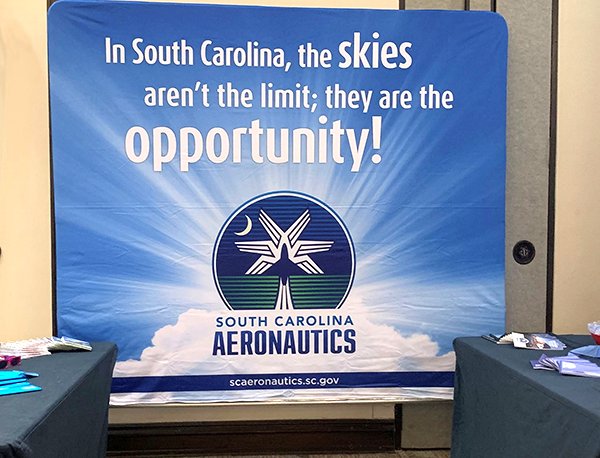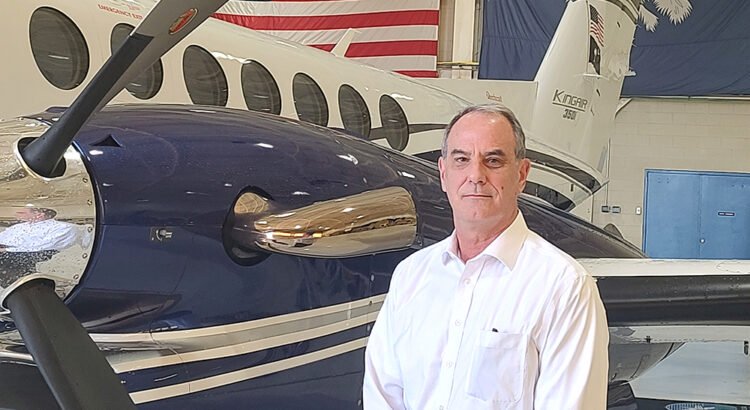Photo above – Gary Siegfried, Executive Director of the South Carolina Aeronautics Commission.
Aviation is having a tremendous impact on the state of South Carolina. Events such as Aviation Week bring together airports, industry leaders, educators, and public officials to highlight the value of aviation to communities throughout the state, and the South Carolina Aeronautics Commission (SCAC) will continue to be “right in the middle of it,” says Gary Siegfried, Executive Director.
While the South Carolina Aviation Association organizes and leads this statewide event, SCAC helps by providing data, expertise, and strategic support that help tell the full story of aviation’s impact in South Carolina. “We work closely with airports, state leaders, and local partners to showcase airport improvement projects funded through state and federal programs, and we use the week to share the latest economic impact data, highlight workforce development efforts, and reinforce the importance of aviation safety and infrastructure planning,” said Siegfried.

The collaboration is seeing results. “I think the future of aviation in South Carolina is on the rise—literally and figuratively. From rising passenger traffic and thriving general aviation to our world-class aerospace industry, the opportunities are tremendous,” noted Siegfried. “Our airports connect communities, fuel local economies, and open doors for tourism and business.”
Siegfried says the Aeronautics Commission is investing in runways and taxiways, supporting education opportunities for the next generation of aviation professionals, and showcasing South Carolina as a place where aviation can truly take off. “Our challenge is to find additional revenue sources to ensure that we can support our airports’ much needed capital improvements.”
The result of this year’s state budget was good news-bad news-good news. “The good news was that we received $5.35M in recurrent funding and $5.0M in one time funding to support our general aviation airports,” said Siegfried. “This will supplement our normal revenue stream of about $13.5M.”
The recurrent funding represents the first time that significant, reliable funding has been added to the agency’s budget. As long as the normal revenue stream remains consistent, the Commission should be in a good position to fund general aviation airports’ capital needs.
“The bad news is that the agency requested significantly more recurrent funding than $5.35M, hoping to implement a new program for our commercial airports,” said Siegfried. “We were not successful this year but hope reigns eternal and we will try again during next year’s budget cycle.”
There was good news however for the commercial service airports in this year’s budget. “The legislature did allocate $80M for commercial airports through the Commerce Department,” noted Siegfried. “So, even though this money is not coming through Aeronautics, it was directed toward the commercial airports to help them with their vital capital improvements, and we consider that a win.”
Although the recurrent funding was not what they hoped it would be, Siegfried believes the fact that they received some reflects a growing recognition by the state leadership of the critical role aviation plays in South Carolina’s economic and community wellbeing. “We are thankful for this show of support and confidence from Governor McMaster and our legislators.”
Funding has always been tight. When Siegfried arrived at Aeronautics in 2016, the agency had about $1.9 million available to support the airport development program. “My predecessors, Paul Werts and James Stephens, laid important groundwork for increased funding, and because of their efforts, we now do a much better job supporting our general aviation airports.”
Going forward, the major emphasis for the Commission remains largely the same as in previous years; The ongoing effort to secure additional funding, especially for the commercial service airports.
When Siegfried became director in September 2022, one of his top priorities was to advocate for state funding for commercial airports. “With our normal revenue stream (airline property tax and aviation fuel tax) and the addition of $5.35M recurring funding, we are able to keep up with most of the general aviation needs,” said Siegfried. “But we will continue to advocate for the commercial service airports to bring them reliable, recurrent state assistance.”
Siegfried says the next point of emphasis is their ongoing challenge with incompatible land uses encroaching upon their airports. “With the explosive growth in South Carolina we are seeing ongoing and increasing development encroachment around our airports. It is crucial that we protect airports so that their utility and safety remain intact.”
There has also been explosive growth in drone technology. Having invested in drones early, the Commission continues to integrate drones into their airport operations in meaningful ways. “They are an essential tool for our airport inspection process, allowing us to safely and efficiently collect detailed imagery of close-in approaches to identify potential obstructions,” said Siegfried. Beyond inspections, they use drones to capture aerial imagery during construction projects, helping to monitor progress and ensure accuracy. “As the technology evolves, we’re exploring new ways drones can support safety, planning, and engineering—making them a versatile and increasingly important part of our toolbox.”
For Siegfried, who plans on retiring at the end of the year, holding the position of Executive Director has been one of the most challenging—and most rewarding—chapters of his career. “South Carolina is growing rapidly, and with that growth comes the challenge of protecting our airports from development encroachment while ensuring they can meet the needs of our communities. It hasn’t always been easy, but I believe I’m leaving the agency stronger than I found it, with our airports better positioned to serve South Carolinians well into the future.”
As for the next chapter in his life, Siegfried does plan to stay connected to aviation in some way, saying, “it’s hard to remember a time when I wasn’t interested in aviation.” But first, he wants to spend a year traveling. There’s a huge part of the United States he’s never seen, and plenty of bucket-list destinations waiting. “Once I’ve had my fill of that adventure, I’ll see where my path in the aviation industry might lead next.”



